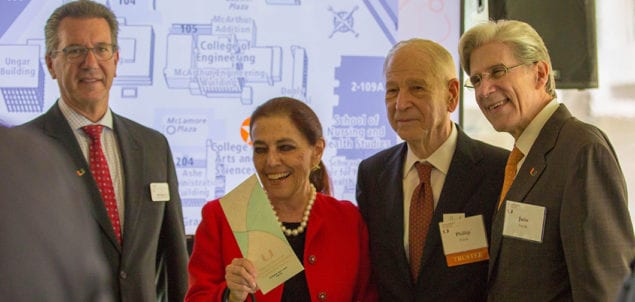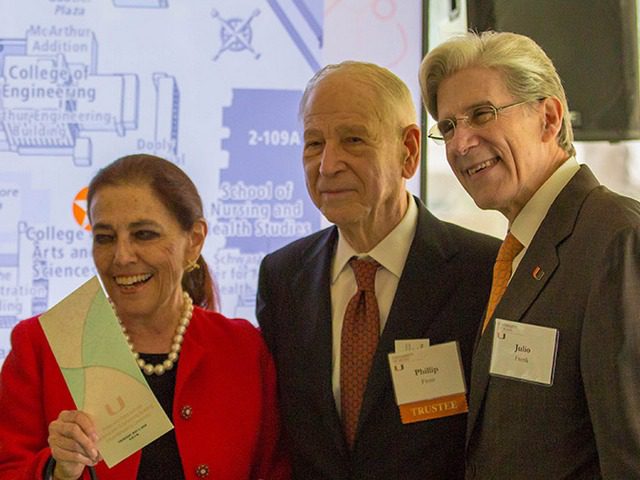
Powerful space telescopes with mirrors thinner than a dime. A miniaturized heart, lung and pancreas that offer a less time-consuming and more effective way to test new drugs. And a drone powered not by batteries but by vibrations.
This isn’t the stuff of science fiction, but the consequence of collaboration among University of Miami researchers — chemists, engineers, mathematicians, and pathologists working together to solve global problems and invent new methods for accomplishing age-old tasks.
Such collaboration took a giant step forward on Thursday, May 3, when UM conducted a ceremonial groundbreaking for its new Phillip and Patricia Frost Science and Engineering Building, a structure that will house an intertwined network of institutes aimed at boosting science, technology, engineering, and math (STEM) across the university.
“This new building will spark innovation, catalyze scientific advances, and position UM for new and groundbreaking research,” said Jean-Pierre Bardet, dean of UM’s College of Engineering.
Both the facility, the design of which is forthcoming, and the network of institutes, where are known as the Frost Institutes of Science and Engineering, are made possible by a landmark $100 million gift from the namesake UM benefactors who have long expressed a commitment to making Miami a hub for technological and scientific innovation.
“If we build the framework from which to provide the education and resources, we will be successful in attracting world-class scientists across various disciplines,” said Phillip Frost, a physician and UM trustee.
“The University of Miami is already known for excellence in biomedicine, marine sciences, and other fields. But continued excellence cannot be sustained without critical investments in basic and applied science, mathematics, and engineering.”UM president Julio Frenk said more than a year ago when the Frost Institutes, which are modeled after the National Institutes of Health, were announced. “These disciplines, which form the building blocks for innovation, must be strengthened to maintain our leading edge as a research university.”
One of those institutes already is up and running. Established in 2017, the Frost Institute of Chemistry and Molecular Science (FICMS) will bring together scientists from several molecular-based disciplines to conduct research using techniques that rely on molecular design, discovery, and development, with the goal of translating their research into solutions for real-world problems. The Institute will combine efforts from existing and new faculty members, primarily from the College of Arts and Sciences, as well as related disciplines in the College of Engineering and the Miller School of Medicine.
Other institutes will follow, with all eventually residing under the roof of the Phillip and Patricia Frost Science and Engineering Building, a facility Engineering Dean Bardet said, “will provide amazing opportunities for our faculty, students, and the greater community.”
“Our faculty and students will work side by side in collaborative spaces, allowing them to see what other groups are working on, discuss new ideas, and create new collaborations that address real-time, real-world challenges,” he added.
Leonidas Bachas, dean of the College of Arts and Sciences, echoed Bardet’s comments, adding that the umbrella structure of the Frost Institutes will lead UM “on a path to new scientific discoveries, innovative teaching, and collaboration across disciplines.”
“As the drivers of boosting scientific breakthroughs in chemistry and molecular science, our talented faculty and students will soon have a place to develop interdisciplinary research across multiple fields and make new groundbreaking advances in the sciences. We thank Phillip and Patricia Frost for this generous gift and for supporting our progress in STEM research,” Bachas said.
Of the Frosts’ $100 million gift, $30 million is designated to the creation of at least 13 chairs in STEM fields, with $3 million set aside for graduate student support.
Attendees at the May 3 ceremonial groundbreaking, which took place on the Coral Gables campus near the existing Cox Science Center and the McArthur Engineering Building, got an up-close look at some of UM’s groundbreaking STEM projects. From new ways of harvesting energy as a pathway to a sustainable future, to the chemical processes involved in identifying cellular targets associated with disease, to next-generation sensors and energy devices used in disease diagnosis, the ceremony featured a series of scientific exhibits offering a glimpse of the nature of research that will be conducted by the Frost Institutes.
Their creation is the backbone of one of the nine transformational initiatives, STEM@UM, to propel the university toward its greatest aspirations by its centennial in 2025, allowing for STEM growth, a stimulation of interdisciplinary research collaboration, and engagement with greater Miami as a hemispheric innovation hub.
The university will launch a national search for an individual to lead the Frost Institutes, with additional institutes to be created over the next several years.






